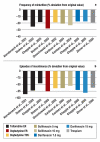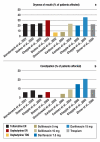Urinary incontinence in the elderly: part 3 of a series of articles on incontinence
- PMID: 20737059
- PMCID: PMC2925344
- DOI: 10.3238/arztebl.2010.0531
Urinary incontinence in the elderly: part 3 of a series of articles on incontinence
Abstract
Background: Urinary incontinence is a common and distressing complaint in the elderly. Its causes include structural changes in vesical muscle as well as impaired neural control and age-related changes of the lower urinary tract. Incontinence can also be a side effect of medication.
Methods: The PubMed database was selectively searched for publications containing the terms "urinary incontinence" and "elderly." Studies with a high level of evidence were chosen as the main basis for this review.
Results: The individualized diagnostic evaluation of the incontinent elderly patient should generally be non-invasive. The evaluation may reveal urinary incontinence of several different types: stress incontinence, overactive bladder, and mixed incontinence. The treatment generally involves medication, such as anti-muscarinic agents, alpha-receptor blockers, and/or serotonin/noradrenalin reuptake inhibitors, combined with modifications of personal behavior, such as bladder training, altered fluid intake, and pelvic floor contraction. A number of minimally invasive surgical techniques can be useful for patients in operable condition, whenever such an operation seems reasonable in view of the patient's overall situation.
Conclusion: Urinary incontinence in the elderly can be readily evaluated, and the currently available forms of treatment often bring satisfactory relief with an economical use of medical resources and with little or no additional discomfort for the patient.
Figures



Similar articles
-
[Urinary incontinence in the elderly].Dtsch Med Wochenschr. 2011 Aug;136(31-32):1574-6. doi: 10.1055/s-0031-1281555. Epub 2011 Aug 1. Dtsch Med Wochenschr. 2011. PMID: 21809244 Review. German. No abstract available.
-
Related factors of urge, stress, mixed urinary incontinence and overactive bladder in reproductive age women in Tabriz, Iran: a cross-sectional study.Int Urogynecol J Pelvic Floor Dysfunct. 2008 Mar;19(3):367-73. doi: 10.1007/s00192-007-0437-2. Epub 2007 Aug 18. Int Urogynecol J Pelvic Floor Dysfunct. 2008. PMID: 17704857
-
[Conservative treatment of urinary incontinence].MMW Fortschr Med. 2007 Sep 20;149(38):30-1; quiz 32. MMW Fortschr Med. 2007. PMID: 18018411 Review. German.
-
[Male urinary incontinence].Ned Tijdschr Geneeskd. 2008 Apr 5;152(14):797-802. Ned Tijdschr Geneeskd. 2008. PMID: 18491821 Review. Dutch.
-
[Epidemiology and etiology of male urinary incontinence].Urologe A. 2010 Apr;49(4):481-8. doi: 10.1007/s00120-010-2263-2. Urologe A. 2010. PMID: 20376650 German.
Cited by
-
The biofeedback therapy in patients with stress incontinence urinary.Nephrourol Mon. 2012 Summer;4(3):591-2. doi: 10.5812/numonthly.4153. Epub 2012 Jun 20. Nephrourol Mon. 2012. PMID: 23573494 Free PMC article. No abstract available.
-
Recurrent hyponatremia due to tolterodine.Can Urol Assoc J. 2012 Jun;6(3):E129-30. doi: 10.5489/cuaj.11071. Can Urol Assoc J. 2012. PMID: 22709885 Free PMC article. No abstract available.
-
Management of patients with urinary incontinence in senior age.Cent Eur J Public Health. 2024 Dec;32(Supplement):91-95. doi: 10.21101/cejph.a7890. Cent Eur J Public Health. 2024. PMID: 39832153
-
National Trends in Medication Prescriptions for Male Lower Urinary Tract Symptoms and Erectile Dysfunction: Findings from the Norwegian Prescription Database.Eur Urol Open Sci. 2025 Apr 9;75:89-93. doi: 10.1016/j.euros.2025.03.013. eCollection 2025 May. Eur Urol Open Sci. 2025. PMID: 40247886 Free PMC article.
-
Improving the health care of geriatric patients: management of urinary incontinence: a position paper.Z Gerontol Geriatr. 2013 Jul;46(5):456-64. doi: 10.1007/s00391-013-0491-y. Z Gerontol Geriatr. 2013. PMID: 23619707 Review.
References
-
- Weltz-Barth A. Inkontinenz im Alter, ein soziales und ökonomisches Problem. Urologe. 2007;46:363–364. - PubMed
-
- Goepel M, Hoffmann JA, Piro M, Rübben H, Michel MC. Prevalence and physician awareness of symptoms of urinary bladder dysfunction. Eur Urol. 2002;41:234–239. - PubMed
-
- Füsgen I, Melchior H. Springer. Berlin-Heidelberg-New York: 1997. Inkontinenzmanual; 55 pp.
-
- Griffith D, Derbyshire S, Stenger A, Resnick N. Brain Control of normal and overactive bladder. J Urol. 2005:1862–1867. - PubMed
-
- Elbadawi A, Yalla SV, Resnick NM. a) Structural basis of geriatric voiding dysfunction. I. J Urol. 1993;150:1650–1656. - PubMed
Publication types
MeSH terms
Substances
LinkOut - more resources
Full Text Sources
Medical

